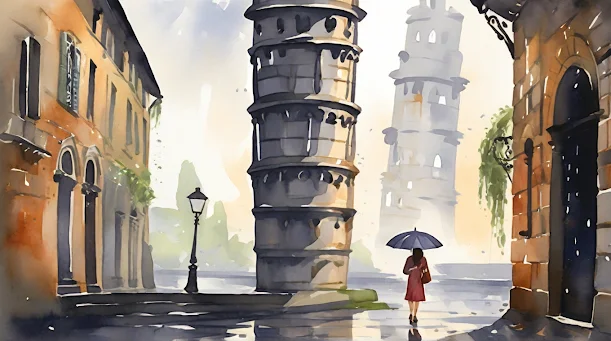Leaning Tower of Pisa.
The Leaning Tower of Pisa, known as "Torre Pendente" in Italian, is one of the most famous architectural wonders in the world. Located in the city of Pisa, Italy, this iconic structure is renowned for its distinctive tilt, which has captured the imagination of visitors for centuries. Beyond its architectural anomaly, the tower also boasts a rich history and cultural significance that has firmly cemented its status as a global landmark.
Construction of the Leaning Tower of Pisa began in 1173 and took approximately 200 years to complete. The tower was intended to be a bell tower for the adjacent Pisa Cathedral, serving as a symbol of the city's wealth and power. However, even during its construction, it became apparent that the tower was leaning due to the soft and unstable ground on which it was built.
The tower stands at a height of 55.86 meters (183.27 feet) and originally had eight stories, including the bell chamber at the top. Its circular design features white marble on the exterior, with columns, arches, and decorative elements that reflect the Romanesque and Gothic architectural styles prevalent during the period.
The most striking feature of the tower is, of course, its lean. The tilt is a result of the uneven settlement of the ground, coupled with the tower's weight and the relatively shallow foundation. At its most extreme, the top of the tower leans about 5.5 degrees from the vertical axis, creating a visually captivating and seemingly precarious sight.
Over the centuries, various attempts were made to stabilize and correct the lean of the tower. In the 1990s, extensive restoration work was carried out to reduce the tilt and ensure the tower's structural integrity. This involved the installation of counterweights and the removal of soil from the higher side of the tower, effectively reducing the lean and ensuring its long-term stability.
Despite its tilt, the Leaning Tower of Pisa has managed to captivate the world with its beauty and uniqueness. Visitors from around the globe flock to Pisa to witness this architectural marvel firsthand and take the obligatory "holding up the tower" photos.
The tower is part of the larger Piazza dei Miracoli, or the Square of Miracles, which is a UNESCO World Heritage site. The square encompasses the Pisa Cathedral, the Baptistery, and the Camposanto Monumentale (Monumental Cemetery), all of which are architectural masterpieces in their own right.
The interior of the Leaning Tower of Pisa is just as impressive as its exterior. The tower features a spiral staircase with 294 steps that leads visitors to the top, offering panoramic views of Pisa and its surroundings. As visitors ascend, they can observe the tower's lean from different angles, adding to the sense of wonder and fascination.
Inside the tower, visitors can also admire the seven magnificent bells housed in the bell chamber. These bells have played an important role in the city's history, marking significant events and celebrations.
The Leaning Tower of Pisa's global fame has made it an enduring symbol of Italy and a testament to human ingenuity and perseverance. It has become a metaphor for the challenges and triumphs of architectural endeavors, and its lean has come to represent the unpredictability and imperfections of life itself.
Beyond its architectural significance, the tower holds great cultural and historical value. It stands as a testament to Pisa's medieval maritime power and its role as an important trading center during the Middle Ages. The tower's lean has become an emblem of the city, a source of pride for its inhabitants, and a cherished symbol of Italy's rich heritage.
In conclusion, the Leaning Tower of Pisa is a remarkable architectural masterpiece that has captured the imagination of people worldwide. Its unique tilt, combined with its historical and cultural significance, has made it an enduring symbol of human achievement and resilience. As visitors continue to marvel at its beauty and wonder, the tower's legacy as an iconic and beloved landmark will undoubtedly endure for generations to come.
| History & Architecture | Leaning Tower of Pisa facts | Informational | Unveiling the Fascinating History of the Leaning Tower of Pisa | Explore the rich history and architectural marvels of the Leaning Tower of Pisa in this detailed overview. Discover intriguing facts and stories surrounding this iconic landmark. |
| Travel & Tourism | Best time to visit Leaning Tower of Pisa | Commercial | Plan Your Perfect Trip: Discover the Best Time to Visit the Leaning Tower of Pisa | Find out the ideal time to experience the Leaning Tower of Pisa, ensuring a memorable and enjoyable journey. |
| Photography & Views | Leaning Tower of Pisa sunset photos | Informational | Capturing Beauty: Tips for Breathtaking Sunset Photos at the Leaning Tower of Pisa | Elevate your photography skills and capture stunning sunset moments with the iconic Leaning Tower of Pisa as your backdrop. |
| Restoration & Preservation | Leaning Tower of Pisa renovation history | Informational | Preserving History: A Deep Dive into the Renovation History of the Leaning Tower of Pisa | Explore the meticulous restoration efforts that have preserved the Leaning Tower of Pisa's structural integrity over the years. |
| Events & Festivals | Leaning Tower of Pisa anniversary celebration | Informational | Celebrating History: Join the Leaning Tower of Pisa's Anniversary Festivities | Dive into the festive spirit as we commemorate the milestones and anniversaries of the renowned Leaning Tower of Pisa. |
| Nearby Attractions | Pisa Cathedral and Baptistery | Informational | Beyond the Lean: Exploring Pisa's Architectural Wonders | Uncover the beauty of Pisa beyond the Leaning Tower, exploring the captivating Cathedral and Baptistery. |
| Travel Tips | Leaning Tower of Pisa ticket prices | Transactional | Smart Planning: Get the Best Deals on Leaning Tower of Pisa Tickets | Save money and ensure a seamless visit by discovering the most cost-effective ways to purchase tickets for the Leaning Tower of Pisa. |

Well done
ReplyDelete